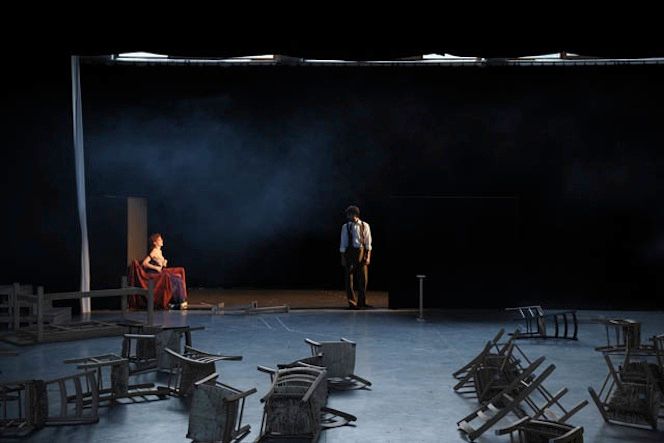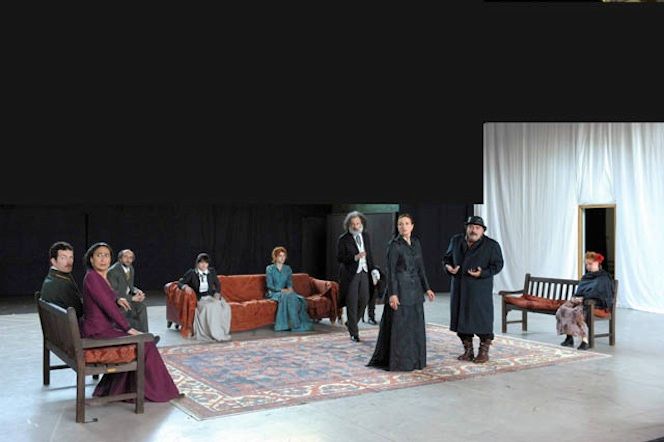Some scenes in I Demoni, Peter Stein's adaptation of Dostoyevsky's novel The Demons, are magnificent, but overall I was underwhelmed. I am glad to have seen it though, because there is much to enjoy, at least in the first hour or two, but as far as I'm concerned the piece could have been reduced to the "Frank Castorf" length of four hours.
I Demoni runs over 11 and a half hours, including six intervals, and comes with a cast of 26 actors. The stage design is sparse. Some chairs, a table, a couch, a moving wall. The music and sound effects are performed live. It is back to basics. Theatre as a community event. The first performances took place at Peter Stein's estate in Umbria, Italy, where performers and (invited) guests enjoyed lunch and dinner together. The tour is more conventional, even though the program booklet promises that the production "will completely reinterpret the connection with the audience that will become active part of the event, and not just mere observers, during the day spent 'together with the play'". (If you want to have a drink with the actors during the performance you should go and see Roman Tragedies by director Ivo van Hove and Toneelgroep Amsterdam).
Peter Stein's adaptation is quite conventional, it is basically a retelling and a reenactment of the 900 page novel. This works well in the early family scenes, but when all hell is supposed to break loose, all that happens is that the chairs are turned over and smoke is blown onto stage. Bringing world events onto stage is difficult. Many directors these days use video projections or television screens, which works sometimes, but not always. The problem is that on stage small events, such as family feuds, can be blown up, but big external events such as war, revolution, natural disasters and so on have to be scaled down. I would have found it more convincing if an actor had simply gone on stage with the novel and briefly talked the audience through some of the events. The same goes for some other scenes which serve the plot and not the drama. A speaker does introduce each section "The Demons, Second Part, Third Chapter" etc. so why not take it one step further?
The piece contains a number of 10 to 20 minute monologues. Since the piece stretches out over several hours there is a place for such lengthy monologues and dialogues. Even so, I found the scenes in which a single person delivers a lengthy monologue on an otherwise empty stage unimaginative.


Peter Stein, I Demoni
The production shines in the ensemble scenes. All actors present on stage remain dynamically engaged, even if for minutes on end they don't have a speaking part. They respond to the speakers or to another person's response or they have a barely audible conversation behind another person's back. Much of this is acted out in the form of gaze direction, posture and gestures. In this you can recognize the hand of a director with an exceptional eye for detail.
Peter Stein's adaptation and direction is consistent throughout, which I find admirable, even though I found some scenes terse and hard-going. Some "postmodern" or "post-dramatic" ploys would have saved the day for me. I guess what I like about some productions by Thomas Ostermeier is that he is unafraid to be inconsistent if the production demands it.
Some weeks ago I wrote that paying 35 euro to see an 11 and a half hour performance is an example of what's wrong with theatre prices in The Netherlands. Knowing what I know now I must say that I would have felt disappointed if the tickets had cost something like 200 euro. Now all I lost was a day and about 40 euro.